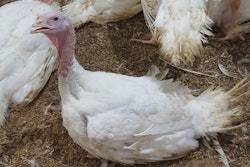State-of-the-art technology is at the forefront in Hendrix Genetics’ first commercial turkey hatchery in North America.
The $30 million, 83,000-square-foot hatchery located in Beresford, South Dakota, hatched its first eggs in December 2018. Tim Hergott, hatchery division manager for turkeys for Hendrix Genetics, said it employs top-of-the-line incubators utilizing advanced hatching software and automates processes to save on labor and enhance both worker and bird welfare.
Beresford’s role in the supply chain
Beresford is the third hatchery built by Hendrix Genetics in the U.S. since 2014, following a parent stock turkey hatchery and a commercial layer hatchery both located in Nebraska.
It hatches eggs supplied from breeder farms located in South Dakota and Minnesota and sends poults to U.S. states including Arkansas, Minnesota, Pennsylvania and Virginia. It is equipped to hatch 35 million eggs annually.
It supports Hendrix’s expansion into the distribution of commercial poults. Its previous turkey hatchery network supported its Hybrid Turkeys parent stock business. As the company expanded into supplying commercial poults, it needed more hatching capacity and more control of its product.
Hergott said the location puts it close to its egg supply and its customers. The town, located about halfway between Sioux Falls, South Dakota, and Sioux City, Iowa, offers a ready supply of labor, too.
Enhanced incubation control
The Beresford hatchery is one of a few in the world using the Petersime BioStreamer incubator. Hergott said the machines feature the OvoScan system which monitors egg shell temperature. It then adjusts the environment inside the incubator to match a pre-set egg shell profile.
Promotional materials from Petersime said the device helps to create an ideal embryonic temperature and controls the rate of metabolic development in the embryo. It is designed to establish the best possible incubation environment for any batch of eggs regardless of size, age or genetic content. This results in lower embryonic mortality and optimizes hatchability.
Hergott said older incubators run off of air temperature measurements alone. The OvoScan equipped machines are set to maintain a certain, desired egg shell temperature. He said it takes the guess work out of creating an egg shell profile. If one is found that improves hatchability, it can run the same profile across different flocks and ages.
He said the BioStreamer helped tighten the facility’s hatch window. Along with the OvoScan system, he said the machine is easy to clean and features user-friendly interface.
Automation for bird and worker welfare
Three processes are currently automated at the hatchery: transferring eggs, separating poults from their shells and servicing hens and toms after sexing. Automating these processes saves some labor, but it’s really about reducing cracks in egg shells and eliminating the need for workers to do tedious and physically stressful jobs in the hatchery.
Dr. Cynthia Philippe, manager of veterinary services and quality assurance for Hendrix Genetics, said the company views it as a matter of providing for both bird and worker welfare. Additionally, automation of processes makes it easier to operate in challenging labor markets.
Greg Perry, assistant hatchery manager for turkeys at Hendrix Genetics, said the transfer robot eliminates the need for workers to lift and stack heavy boxes all day. It also reduces cracks caused by the transfer process. The separator, Hergott said, handles a dirty, undesirable job in the hatchery.
The use of new Nova-Tech MPSP machines halves the amount of labor needed for treatment of the birds. The newer machines can handle toe and beak treatment as well as vaccination in a single unit, something older models could not.
Further automating processes
There is a possibility of further automating processes in the hatchery. The management staff said the potential exists in every department. It could install devices that automatically place eggs in the incubator trays in the egg room. Another piece could be added to its transfer robot to unstack the incubator trolley trays and place them onto conveyor belts. At the end of the line, automatic counters and boxers can be installed and a robot to stack the boxes of poults can be employed.
Hergott said these realistic options are future considerations which will be weighed on their ability to improve efficiency and ergonomics for its staff of 60.
Expansion in the future
The hatchery, which currently features 100 incubators and 18 hatchers, is built to be expanded should the need arise. Perry said it was designed for expansion in all directions in anticipation of elevated demand in the future. Hergott said any decision to grow the hatchery would depend on customer reception.
“Quality for us is incredibly important. We have to prove ourselves,” Hergott said. “As our quality improves from day one to now and further in the future … repeat customers and additional customers will really be the tell-tale sign of whether and when we expand.”
Read more:
Troubleshooting fertility problems in turkeys, www.WATTAgNet.com/34766


















